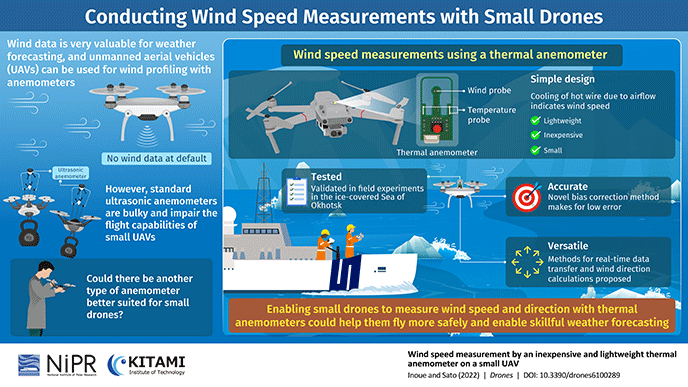National Institute of Polar Research
Using Small Drones to Measure Wind Speeds in the Polar Regions
Researchers test a new method for wind profiling using small drones equipped with lightweight thermal anemometers
October 28, 2022
Small drones can conduct wind speed measurements in regions where weather stations are difficult to set up and maintain, such as the Arctic region. However, standard ultrasonic anemometers used for wind profiling are too heavy for small drones. To tackle this, Japanese researchers have now tested and validated the use of lightweight thermal anemometers on small drones to accurately measure wind speeds in the Okhotsk Sea, opening doors to a more sustainable polar atmospheric science.
Movie: The research team flew their drone over the ice-covered Okhotsk Sea while aboard the Japanese Patrol Vessel Soya to make wind speed measurements.
Drones and similar small unmanned aerial vehicles (sUAVs) have seen a massive surge in popularity over the past few years owing to their innovative applications, such as crop monitoring, search and rescue operations, and coast profiling. The potential of sUAVs in atmospheric science and meteorology has not gone unnoticed either as drones offer an efficient way to place various kinds of sensors up above in the lower atmosphere.
As evidenced by pioneering studies led by the National Institute of Polar Research, Japan, small drones bearing meteorology sensors can be useful for weather forecasting in places where weather stations are scarce or costly to set up and maintain, such as the polar regions. With the use of drones, invaluable data could be gathered for making numerical weather predictions and improving climate models.
However, several practical challenges remain to be addressed on this front. One clear example is measurement of wind speeds for wind profiling. While a few companies are commercializing drones for conducting wind speed measurements, these drones tend to be large and expensive. This is because the ultrasonic anemometers that they carry are heavy and bulky. On the other hand, although wind speed could in theory be calculated from the drone’s internal flight log data, there is no way to access these data in most commercial drones. Thus, with no alternative methods to measure wind speed, application of sUAVs remain limited.
To tackle this issue, Associate Professor Jun Inoue of the National Institute of Polar Research and Assistant Professor Kazutoshi Sato of the Kitami Institute of Technology, both in Japan, have recently conducted a study in which they tested and validated a new wind speed measurement device compatible with sUAVs: thermal anemometers. As explained in their paper published in MDPI’s Drones published on October 3, 2022, thermal anemometers, also called “hot-wire anemometers,” are small electronic devices that can indirectly measure wind speed based on how fast a heated wire cools down over time due to air flow. These sensors are ideal for sUAVs as they are extremely lightweight (~ 1 g) and inexpensive (<200 USD).
The researchers tested their approach in the lab as well as on the field. In the laboratory experiments, they flew a small quadcopter drone equipped with a thermal anemometer in front of large fans. Using smoke machines, high-speed cameras, lasers, and image analysis software, they analyzed how the air flow was disturbed by the drone as it ascended. Using these data, they created a bias correction algorithm, which enabled the drone to make more accurate wind speed measurements.
Movie: Smoke Visualization Experiment. The experiments were supported by Shin Nippon Air Technologies Co., Ltd.
For the field experiments, the team flew their drone over the ice-covered Okhotsk Sea while aboard the Japanese Patrol Vessel Soya to make wind speed measurements. Upon comparing the data gathered by their drone with that from an ultrasonic anemometer on the ship, the team found them to be in agreement, suggesting that the drone’s measurements were highly reliable. “The root-mean-square error was ±1.13 m/s, suggesting that the proposed correction method was accurate and well within the requirement for numerical weather predictions,” remarks Dr. Inoue.
Overall, this alternative approach to wind profiling is definitely promising on various fronts. To top it off, the researchers also proposed two additional techniques that could be pursued in future works: calculating both wind direction and speed using two thermal anemometers and transferring the gathered data in real time.
Wind speed measurements are not just relevant for climate science and weather forecasting. The drones themselves can benefit from knowing the wind conditions they are flying in as it enables them to stabilize their flight better. “The flight style of drones has changed from flying within the operator’s visual line of sight to flying beyond the visual line of sight. This is because they are now routinely used for long-range delivery and surveys of disasters and forest fires,” highlights Dr. Sato. “Once we can monitor the wind conditions in all kinds of drones in real time, operators will be able to focus more on their task without having to worry about the drone’s stability and safety,” he concludes.
Let us hope this study brings positive winds of change to meteorology and flying drones alike!

Figure: Conducting wind speed measurements with small drones. Drones are extremely useful for conducting wind speed measurements over regions where it is difficult to set up or maintain weather stations, such as the Arctic region. However, conventional measurement devices, called ultrasonic anemometers, are too bulky for small drones, raising drone costs. Now, researchers from Japan find a way around this problem, using lightweight thermal anemometers, which can be mounted on small drones for accurate wind speed profiling. Credit: Jun Inoue (NIPR)
Original article:
Journal: Drones
Title: Wind Speed Measurement by an Inexpensive and Lightweight Thermal Anemometer on a Small UAV
Authors:
Jun Inoue (National Institute of Polar Research, Japan)
Kazutoshi Sato (Kitami Institute of Techology, Japan)
DOI: 10.3390/drones6100289
URL: https://www.mdpi.com/2504-446X/6/10/289
Published: October 3, 2022
Funder:
This research was funded by The Arctic Challenge for Sustainability II project grant number JPMXD1420318865. The APC was funded by the National Institute of Polar Research, Research Organization of Information and Systems.








